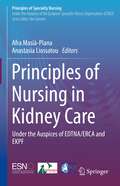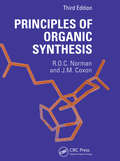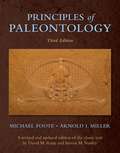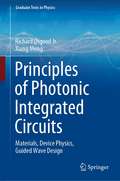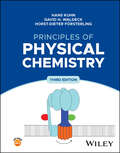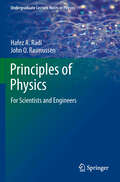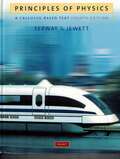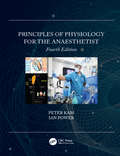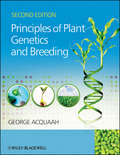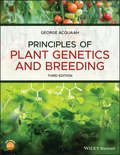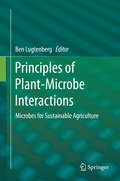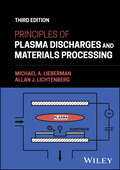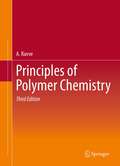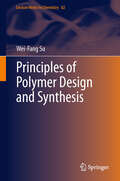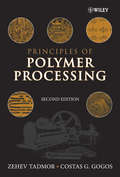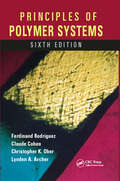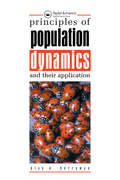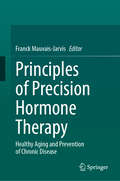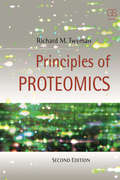- Table View
- List View
Principles of Nursing in Kidney Care: Under the Auspices of EDTNA/ERCA and EKPF (Principles of Specialty Nursing)
by Afra Masià-Plana Anastasia LiossatouThis textbook, endorsed by EDTNA/ERCA and ESNO, provides unique evidence-based knowledge about nursing in renal care and harmonises specialised understandings from various countries, to be implemented across numerous national health systems. Renal care nursing is essential in order to promote and prevent renal health as well as detect and contribute to the care of renal disease. These complex tasks require specialised knowledge and training to ensure patient safety and positive outcomes in patient care. This book describes in detail the highest quality practices in different stages of the disease. Twenty-three chapters reflect evidence-based or consensus in practise, covering management and treatment in patient centred care procedures. Combining expert knowledge from many countries, this textbook can be used for teaching new staff in renal care as well as reviewing and updating renal care expertise. Technological developments have significantly expanded in recent years. In this context renal nurses are responsible not only for individualised, comprehensive, and complex patient care, but also advanced technical skills such as haemodialysis treatment, which require close monitoring of patients to ensure safety. Infection prevention and control is vital throughout patient care. In addition, advanced renal nursing skills have been established for the assessment and management of renal disease. The textbook is unique as in one single volume there is evidence, up to date and rigorous data describing different types of renal care therefore it is possible to concept a holistic vision of CKD patients as well as the nursing perspective.
Principles of Optics
by Max Born Emil WolfPrinciples of Optics is one of the classic science books of the twentieth century, and probably the most influential book in optics published in the past 40 years. The new edition is the first ever thoroughly revised and expanded edition of this standard text. Among the new material, much of which is not available in any other optics text, is a section on the CAT scan (computerized axial tomography), which has revolutionized medical diagnostics. The book also includes a new chapter on scattering from inhomogeneous media which provides a comprehensive treatment of the theory of scattering of scalar as well as of electromagnetic waves, including the Born series and the Rytov series. The chapter also presents an account of the principles of diffraction tomography - a refinement of the CAT scan - to which Emil Wolf, one of the authors, has made a basic contribution by formulating in 1969 what is generally regarded to be the basic theorem in this field. The chapter also includes an account of scattering from periodic potentials and its connection to the classic subject of determining the structure of crystals from X-ray diffraction experiments, including accounts of von Laue equations, Bragg's law, the Ewald sphere of reflection and the Ewald limiting sphere, both generalized to continuous media. These topics, although originally introduced in connection with the theory of X-ray diffraction by crystals, have since become of considerable relevance to optics, for example in connection with deep holograms. Other new topics covered in this new edition include interference with broad-band light, which introduces the reader to an important phenomenon discovered relatively recently by Emil Wolf, namely the generation of shifts of spectral lines and other modifications of spectra of radiated fields due to the state of coherence of a source. There is also a section on the so-called Rayleigh-Sommerfield diffraction theory which, in recent times, has been finding increasing popularity among optical scientists. There are also several new appendices, including one on energy conservation in scalar wavefields, which is seldom discussed in books on optics. The new edition of this standard reference will continue to be invaluable to advanced undergraduates, graduate students and researchers working in most areas of optics.
Principles of Optics for Engineers
by Chang, William S. C.Uniting classical and modern photonics approaches by presenting optical analyses as solutions of Maxwell's equations, this unique book enables students and practising engineers to fully understand the similarities and differences between the different methods. The book begins with a thorough discussion of plane wave analysis, which provides a clear understanding of optics without considering boundary condition or device configuration. It then goes on to cover diffraction analysis of many applications, including a rigorous analysis of TEM waves using Maxwell's equations with boundaries. Laser cavity modes and Gaussian beams are presented, modal analysis is covered, and approximation methods are discussed (including the perturbation technique, coupled mode analysis, and super mode analysis). With theory linked to practical examples throughout, it provides a clear understanding of the interplay between plane wave, diffraction and modal analysis, and how the different techniques can be applied to various areas including imaging, signal processing, and optoelectronic devices.
Principles of Optics: 60th Anniversary Edition
by Max Born Emil WolfPrinciples of Optics is one of the most highly cited and most influential physics books ever published, and one of the classic science books of the twentieth century. To celebrate the 60th anniversary of this remarkable book's first publication, the seventh expanded edition has been reprinted with a special foreword by Sir Peter Knight. The seventh edition was the first thorough revision and expansion of this definitive text. Amongst the material introduced in the seventh edition is a section on CAT scans, a chapter on scattering from inhomogeneous media, including an account of the principles of diffraction tomography, an account of scattering from periodic potentials, and a section on the so-called Rayleigh–Sommerfield diffraction theory. This expansive and timeless book continues to be invaluable to advanced undergraduates, graduate students and researchers working in all areas of optics.
Principles of Organic Synthesis, 3rd Edition
by Richard O.C. NormanThis book is designed for those who have had no more than a brief introduction to organic chemistry and who require a broad understanding of the subject. The book is in two parts. In Part I, reaction mechanism is set in its wider context of the basic principles and concepts that underlie chemical reactions: chemical thermodynamics, structural theory, theories of reaction kinetics, mechanism itself and stereochemistry. In Part II these principles and concepts are applied to the formation of particular types of bonds, groupings, and compounds. The final chapter in Part II describes the planning and detailed execution of the multi-step syntheses of several complex, naturally occurring compounds.
Principles of Paleontology, Third Edition
by Michael Foote Arnold I. MillerWhen published in 1971, Principles of Paleontology (POP) by David Raup and Steven Stanley revolutionized both textbooks and teaching in paleontology by adopting an approach that focused on the process of studying biologic groups, rather than a systematic approach (the study of individual groups of organisms), or an historical approach (narrating events to date). For this highly anticipated revision of Raup and Stanley’s one-term undergraduate text, two of Raup’s former students―Michael Foote and Arnold Miller―use that defining core approach to present a thoroughly up-to-date portrait of a field that has undergone major transformations in the last two decades.
Principles of Photonic Integrated Circuits: Materials, Device Physics, Guided Wave Design (Graduate Texts in Physics)
by Richard Osgood jr. Xiang MengThis graduate-level textbook presents the principles, design methods, simulation, and materials of photonic circuits. It provides state-of-the-art examples of silicon, indium phosphide, and other materials frequently used in these circuits, and includes a thorough discussion of all major types of devices. In addition, the book discusses the integrated photonic circuits (chips) that are currently increasingly employed on the international technology market in connection with short-range and long-range data communication. Featuring references from the latest research in the field, as well as chapter-end summaries and problem sets, Principles of Photonic Integrated Circuits is ideal for any graduate-level course on integrated photonics, or optical technology and communication.
Principles of Physical Chemistry
by Hans Kuhn Horst-Dieter Försterling David H. WaldeckCore textbook showcasing the broad scope and coherence of physical chemistry Principles of Physical Chemistry introduces undergraduate students to the concepts and methods of physical chemistry, which are fundamental to all of Chemistry. In their unique approach, the authors guide students along a logically consistent pathway from the principles of quantum mechanics and molecular structure to the properties of ensembles and supramolecular machines, with many examples from biology and nanoscience. By systematically proceeding from atoms to increasingly complex forms of matter, the book elucidates the connection between recognizable paradigms and modern chemistry research in a student-friendly manner. To promote intuition and understanding for beginning students, the text introduces concepts before proceeding to more rigorous treatments. Rigorous proofs and derivations are provided, as electronic supplements, for more advanced students. The book poses over 900 exercises and problems to help the student learn and master methods for physicochemical reasoning. Computational supplementary material, including Fortran simulations, MathCAD exercises, and Mathematica programs, are included on a companion website. Some topics discussed in the text are: Electronic structure and Variational Principle, including Pauli exclusion, spin-orbit interactions, and electron confinement in quantum dots.Chemical bonding and molecular structure, including electron tunneling, comparison of electron-in-a-box models and electron orbital methods, and the mechanics of chemical bonds.Absorption and emission of light, including transition dipoles for π-electron systems, coupled chromophores, excitons, and chiroptical activity.Statistical description of molecular ensembles, including microscopic interpretations of phase transitions, entropy, work, and heat.Chemical equilibria, including statistical description of equilibrium constants, electrochemistry, and the exposition of fundamental reaction types.Reaction kinetics and reaction dynamics, including nonlinear coupled reactions, femtochemistry, and solvent effects on reactions.Physicochemical properties of macromolecules and the principles of supramolecular assemblies, including polymer dynamics and chemical control of interfaces. The logic of supramolecular machines and their manipulation of photon, electron, and nuclear motion. With its highly coherent and systematic approach to the subject, Principles of Physical Chemistry is an ideal textbook and resource for students in undergraduate physical chemistry courses, especially those in programs of study related to chemistry, engineering, and molecular and chemical biology.
Principles of Physics
by Hafez A Radi John O RasmussenThis textbook presents a basic course in physics to teach mechanics, mechanical properties of matter, thermal properties of matter, elementary thermodynamics, electrodynamics, electricity, magnetism, light and optics and sound. It includes simple mathematical approaches to each physical principle, and all examples and exercises are selected carefully to reinforce each chapter. In addition, answers to all exercises are included that should ultimately help solidify the concepts in the minds of the students and increase their confidence in the subject. Many boxed features are used to separate the examples from the text and to highlight some important physical outcomes and rules. The appendices are chosen in such a way that all basic simple conversion factors, basic rules and formulas, basic rules of differentiation and integration can be viewed quickly, helping student to understand the elementary mathematical steps used for solving the examples and exercises. Instructors teaching form this textbook will be able to gain online access to the solutions manual which provides step-by-step solutions to all exercises contained in the book. The solutions manual also contains many tips, colored illustrations, and explanations on how the solutions were derived.
Principles of Physics: A Calculus-Based Text
by Raymond A. Serway John W. JewettThis successful text was the first to address the latest teaching and learning trends as suggested by the Introductory University Physics Project (IUPP) guidelines. PRINCIPLES OF PHYSICS features a concise approach to traditional topics, an early introduction to modern physics, integration of physics education research pedagogies, as well as the integration of contemporary topics throughout the text. This revision of PRINCIPLES OF PHYSICS also contains text/media integration unlike no other through the PhysicsNow online assessment, tutorial, and course management system.
Principles of Physics: For Scientists and Engineers (Undergraduate Lecture Notes in Physics)
by Hafez A Radi John O RasmussenThis textbook presents a basic course in physics to teach mechanics, mechanical properties of matter, thermal properties of matter, elementary thermodynamics, electrodynamics, electricity, magnetism, light and optics and sound. It includes simple mathematical approaches to each physical principle, and all examples and exercises are selected carefully to reinforce each chapter. In addition, answers to all exercises are included that should ultimately help solidify the concepts in the minds of the students and increase their confidence in the subject. Many boxed features are used to separate the examples from the text and to highlight some important physical outcomes and rules. The appendices are chosen in such a way that all basic simple conversion factors, basic rules and formulas, basic rules of differentiation and integration can be viewed quickly, helping student to understand the elementary mathematical steps used for solving the examples and exercises.Instructors teaching form this textbook will be able to gain online access to the solutions manual which provides step-by-step solutions to all exercises contained in the book. The solutions manual also contains many tips, coloured illustrations, and explanations on how the solutions were derived.
Principles of Physiology for the Anaesthetist
by Peter Kam Ian PowerThis book provides readers with an anaesthesia-focused alternative to general physiology textbooks. The new edition has been reorganised with the trainee anaesthesist in mind, into shorter bite-sized chapters ideal for exam revision. The content includes the physiology of all major organ systems, with specific emphasis on the nervous, respiratory, and cardiovascular systems as well as special sections on pain, aging, specific environments and obesity. Alongside the learning objectives, reflection points and a handy summary of physiological equations and tables, there is greater emphasis on clinical application in this fourth edition, with applied physiology included in almost every section.
Principles of Planetary Climate
by Raymond T. PierrehumbertThis book introduces the reader to all the basic physical building blocks of climate needed to understand the present and past climate of Earth, the climates of Solar System planets, and the climates of extrasolar planets. These building blocks include thermodynamics, infrared radiative transfer, scattering, surface heat transfer and various processes governing the evolution of atmospheric composition. Nearly four hundred problems are supplied to help consolidate the reader's understanding, and to lead the reader towards original research on planetary climate. This textbook is invaluable for advanced undergraduate or beginning graduate students in atmospheric science, Earth and planetary science, astrobiology, and physics. It also provides a superb reference text for researchers in these subjects, and is very suitable for academic researchers trained in physics or chemistry who wish to rapidly gain enough background to participate in the excitement of the new research opportunities opening in planetary climate.
Principles of Plant Genetics and Breeding
by George AcquaahTo respond to the increasing need to feed the world's population as well as an ever greater demand for a balanced and healthy diet there is a continuing need to produce improved new cultivars or varieties of plants, particularly crop plants. The strategies used to produce these are increasingly based on our knowledge of relevant science, particularly genetics, but involves a multidisciplinary understanding that optimizes the approaches taken.Principles of Plant Genetics and Breeding, 2nd Edition introduces both classical and molecular tools for plant breeding. Topics such as biotechnology in plant breeding, intellectual property, risks, emerging concepts (decentralized breeding, organic breeding), and more are addressed in the new, updated edition of this text. Industry highlight boxes are included throughout the text to contextualize the information given through the professional experiences of plant breeders. The final chapters provide a useful reference on breeding the largest and most common crops.Up-to-date edition of this bestselling book incorporating the most recent technologies in the fieldCombines both theory and practice in modern plant breedingUpdated industry highlights help to illustrate the concepts outlined in the textSelf assessment questions at the end of each chapter aid student learning Accompanying website with artwork from the book available to instructors
Principles of Plant Genetics and Breeding
by George AcquaahThe revised edition of the bestselling textbook, covering both classical and molecular plant breeding Principles of Plant Genetics and Breeding integrates theory and practice to provide an insightful examination of the fundamental principles and advanced techniques of modern plant breeding. Combining both classical and molecular tools, this comprehensive textbook describes the multidisciplinary strategies used to produce new varieties of crops and plants, particularly in response to the increasing demands to of growing populations. Illustrated chapters cover a wide range of topics, including plant reproductive systems, germplasm for breeding, molecular breeding, the common objectives of plant breeders, marketing and societal issues, and more. Now in its third edition, this essential textbook contains extensively revised content that reflects recent advances and current practices. Substantial updates have been made to its molecular genetics and breeding sections, including discussions of new breeding techniques such as zinc finger nuclease, oligonucleotide directed mutagenesis, RNA-dependent DNA methylation, reverse breeding, genome editing, and others. A new table enables efficient comparison of an expanded list of molecular markers, including Allozyme, RFLPs, RAPD, SSR, ISSR, DAMD, AFLP, SNPs and ESTs. Also, new and updated “Industry Highlights” sections provide examples of the practical application of plant breeding methods to real-world problems. This new edition: Organizes topics to reflect the stages of an actual breeding project Incorporates the most recent technologies in the field, such as CRSPR genome edition and grafting on GM stock Includes numerous illustrations and end-of-chapter self-assessment questions, key references, suggested readings, and links to relevant websites Features a companion website containing additional artwork and instructor resources Principles of Plant Genetics and Breeding offers researchers and professionals an invaluable resource and remains the ideal textbook for advanced undergraduates and graduates in plant science, particularly those studying plant breeding, biotechnology, and genetics.
Principles of Plant-Microbe Interactions
by Ben LugtenbergThe use of microbial plant protection products is growing and their importance will strongly increase due to political and public pressure. World population is growing and the amount of food needed by 2050 will be double of what is produced now whereas the area of agricultural land is decreasing. We must increase crop yield in a sustainable way. Chemical plant growth promoters must be replaced by microbiological products. Also here, the use of microbial products is growing and their importance will strongly increase. A growing area of agricultural land is salinated. Global warming will increase this process. Plants growth is inhibited by salt or even made impossible and farmers tend to disuse the most salinated lands. Microbes have been very successfully used to alleviate salt stress of plants. Chemical pollution of land can make plant growth difficult and crops grown are often polluted and not suitable for consumption. Microbes have been used to degrade these chemical pollutants.
Principles of Plasma Discharges and Materials Processing
by Michael A. Lieberman Allan J. LichtenbergA new edition of this industry classic on the principles of plasma processing Plasma-based technology and materials processes have been central to the revolution of the last half-century in micro- and nano-electronics. From anisotropic plasma etching on microprocessors, memory, and analog chips, to plasma deposition for creating solar panels and flat-panel displays, plasma-based materials processes have reached huge areas of technology. As key technologies scale down in size from the nano- to the atomic level, further developments in plasma materials processing will only become more essential. Principles of Plasma Discharges and Materials Processing is the foundational introduction to the subject. It offers detailed information and procedures for designing plasma-based equipment and analyzing plasma-based processes, with an emphasis on the abiding fundamentals. Now fully updated to reflect the latest research and data, it promises to continue as an indispensable resource for graduate students and industry professionals in a myriad of technological fields. Readers of the third edition of Principles of Plasma Discharges and Materials Processing will also find: Extensive figures and tables to facilitate understanding A new chapter covering the recent development of processes involving high-pressure capacitive discharges New subsections on discharge and processing chemistry, physics, and diagnostics Principles of Plasma Discharges and Materials Processing is ideal for professionals and process engineers in the field of plasma-assisted materials processing with experience in the field of science or engineering. It is the premiere world-wide basic text for graduate courses in the field.
Principles of Plasma Physics for Engineers and Scientists
by Umran Inan Marek GołkowskiThis unified introduction provides the tools and techniques needed to analyze plasmas and connects plasma phenomena to other fields of study. Combining mathematical rigor with qualitative explanations, and linking theory to practice with example problems, this is a perfect textbook for senior undergraduate and graduate students taking one-semester introductory plasma physics courses. For the first time, material is presented in the context of unifying principles, illustrated using organizational charts, and structured in a successive progression from single particle motion, to kinetic theory and average values, through to collective phenomena of waves in plasma. This provides students with a stronger understanding of the topics covered, their interconnections, and when different types of plasma models are applicable. Furthermore, mathematical derivations are rigorous, yet concise, so physical understanding is not lost in lengthy mathematical treatments. Worked examples illustrate practical applications of theory and students can test their new knowledge with 90 end-of-chapter problems.
Principles of Polymer Chemistry
by A. RavveThis successful textbook undergoes a change of character in the third edition. Where earlier editions covered organic polymer chemistry, the third edition covers both physical and organic chemistry. Thus kinetics and thermodynamics of polymerization reactions are discussed. This edition is also distinct from all other polymer textbooks because of its coverage of such currently hot topics as photonic polymers, electricity conducting polymers, polymeric materials for immobilization of reagents and drug release, organic solar cells, organic light emitting diodes. This textbook contains review questions at the end of every chapter, references for further reading, and numerous examples of commercially important processes.
Principles of Polymer Design and Synthesis
by Wei-Fang SuHow can a scientist or engineer synthesize and utilize polymers to solve our daily problems? This introductory text, aimed at the advanced undergraduate or graduate student, provides future scientists and engineers with the fundamental knowledge of polymer design and synthesis to achieve specific properties required in everyday applications. In the first five chapters, this book discusses the properties and characterization of polymers, since designing a polymer initially requires us to understand the effects of chemical structure on physical and chemical characteristics. Six further chapters discuss the principles of polymerization reactions including step, radical chain, ionic chain, chain copolymerization, coordination and ring opening. Finally, material is also included on how commonly known polymers are synthesized in a laboratory and a factory. This book is suitable for a one semester course in polymer chemistry and does not demand prior knowledge of polymer science.
Principles of Polymer Processing
by Costas G. Gogos Zehev TadmorThoroughly revised edition of the classic text on polymer processingThe Second Edition brings the classic text on polymer processing thoroughly up to date with the latest fundamental developments in polymer processing, while retaining the critically acclaimed approach of the First Edition. Readers are provided with the complete panorama of polymer processing, starting with fundamental concepts through the latest current industry practices and future directions. All the chapters have been revised and updated, and four new chapters have been added to introduce the latest developments.Readers familiar with the First Edition will discover a host of new material, including:* Blend and alloy microstructuring* Twin screw-based melting and chaotic mixing mechanisms* Reactive processing* Devolatilization--theory, mechanisms, and industrial practice* Compounding--theory and industrial practice* The increasingly important role of computational fluid mechanics* A systematic approach to machine configuration designThe Second Edition expands on the unique approach that distinguishes it from comparative texts. Rather than focus on specific processing methods, the authors assert that polymers have a similar experience in any processing machine and that these experiences can be described by a set of elementary processing steps that prepare the polymer for any of the shaping methods. On the other hand, the authors do emphasize the unique features of particular polymer processing methods and machines, including the particular elementary step and shaping mechanisms and geometrical solutions.Replete with problem sets and a solutions manual for instructors, this textbook is recommended for undergraduate and graduate students in chemical engineering and polymer and materials engineering and science. It will also prove invaluable for industry professionals as a fundamental polymer processing analysis and synthesis reference.
Principles of Polymer Systems
by Ferdinand Rodriguez Claude Cohen Christopher K. Ober Lynden ArcherA classic text in the field of chemical engineering, this revised sixth edition offers a comprehensive exploration of polymers at a level geared toward upper-level undergraduates and beginning graduate students. It contains more theoretical background for some of the fundamental concepts pertaining to polymer structure and behavior, while also providing an up-to-date discussion of the latest developments in polymerization systems. New problems have been added to several of the chapters, and a solutions manual is available upon qualifying course adoption.
Principles of Population Dynamics and Their Application
by Alan A. BerrymanThis book provides an introduction to population dynamics, exploring rules that govern change in any dynamic system and applying these general principles to populations of living organisms. Principles of Population Dynamics and their Application is aimed at applied ecologists, resource managers. and pest managers. It is also aimed at undergraduate students taking courses in forestry, fisheries, widlife and pest management.
Principles of Precision Hormone Therapy: Healthy Aging and Prevention of Chronic Disease
by Franck Mauvais-JarvisHormones—such as estrogens, testosterone, thyroid hormones, and growth hormone—are essential for metabolic homeostasis in all cells. However, their levels decline with age, contributing to aging and chronic disease. Proper hormone therapy can help delay the onset of age-related diseases, yet there is currently no authoritative, up-to-date resource on precision hormone optimization for healthy aging. Current standard of care textbooks rely on outdated concepts, while books aimed at non-specialist clinicians and patients are often written by non-experts and lack a solid scientific foundation. This book bridges that gap by presenting cutting-edge scientific data and insights from leading academic and private practice experts on the role of hormone optimization in healthy aging. It dispels common misconceptions about hormone therapy risks and highlights the proven benefits of precision hormone treatments. Drawing on both scientific evidence and clinical experience, it explores the distinctions between synthetic hormones and bioidentical, physiological hormones. Designed to challenge conventional thinking, this book aims to inspire discussion and further research among scientists and healthcare practitioners. It is an essential resource for basic and clinical researchers seeking translational knowledge on hormone therapy, as well as clinicians looking to integrate hormone optimization into their practice.
Principles of Proteomics
by Richard Twyman Ph.D Cfe George A.Principles of Proteomics, Second Edition, provides a concise and user-friendly introduction to the diverse technologies used for the large-scale analysis of proteins, as well as their applications, and their impact in areas such as drug discovery, agriculture, and the fight against disease. Proteomics is a fast-advancing field in which researchers seek to capture all the proteins in the cell and characterize them in ever more detail. Principles of Proteomics has been fully updated to reflect the most recent developments in the field without losing its focus on the underlying principles. With worked examples, case studies profiling both established and emerging technologies, and further reading lists for each chapter, Principles of Proteomics is an ideal introduction for students, researchers and those working in the industry.
